Something’s missing from Canada’s plaques and monuments
From heritage sites to John A. Macdonald’s statue, we need to reconsider how we selectively...
There’s a pit in the small eastern Ontario town of Marmora that could nearly swallow Toronto’s financial district. Narrow roadways ring around its edges, rising up from the bottom where hundreds of thousands of tons of iron ore was extracted. The pit fills naturally with cool cyan water that draws in tourists, occasionally enticing trespassers to take a dive. Now, the former open-pit mine offers an opportunity for hydroelectric energy production and — perhaps even more exciting — storage of fleeting renewable energy. And a lot of it.
“The horseshoe at Niagara Falls would cover maybe a third of this, you’d probably have to wrap it around four-to-five times,” says John Wright, director of business development at Northland Power.
His company is hoping to work with Ontario Power Generation to transform the site. “That’s why you can store so much energy: it’s massive, it’s just massive.”
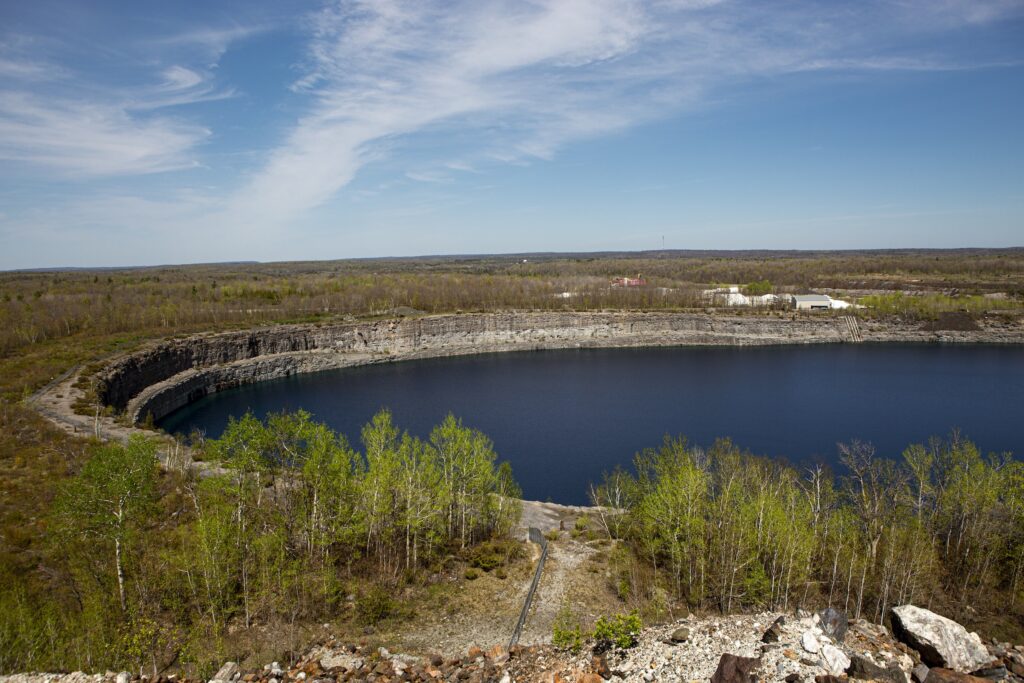
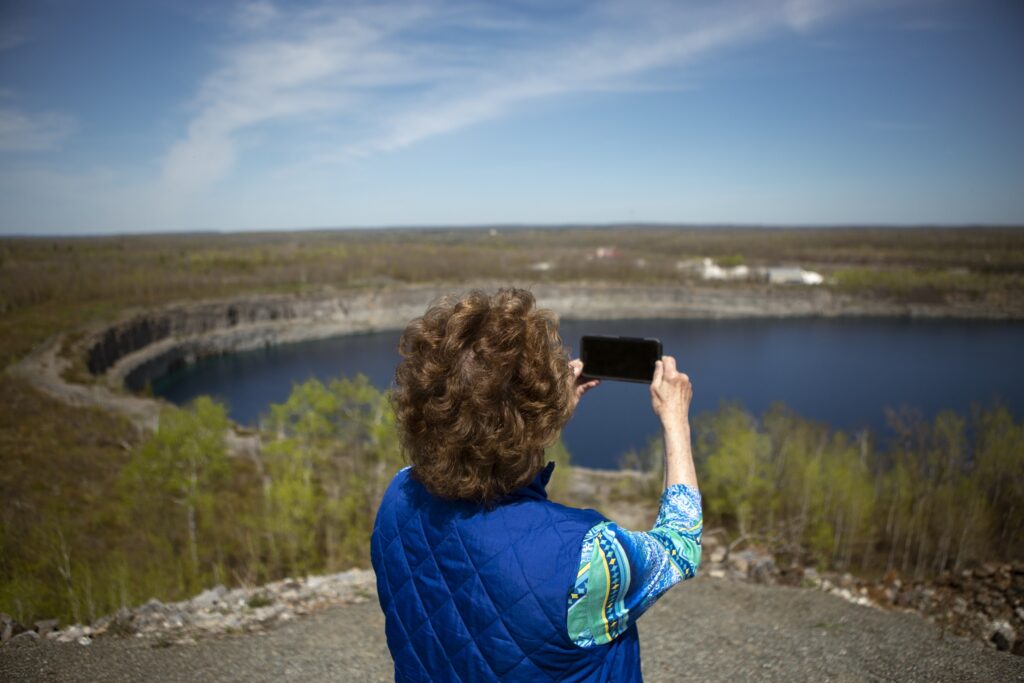
The pit left from the former Marmoraton mine is 850 metres long, 450 metres wide and 213 metres deep. A few years ago, back in the financial district, Wright gave a presentation on the site’s green energy potential, on the 45th floor of the Scotiabank Plaza. If that building were seated in Marmora’s pit, he told the audience, gazing out the window at the city below, they’d all be looking up at waste rock cliffs.
In 2011, Northland first proposed converting the former Marmoraton site so it could do two things: generate hydroelectricity and become a battery. The second would be done using a process called “pumped storage” in which excess renewable energy pumps water into a reservoir — in that way, charging it — so it can be released to generate hydroelectricity when needed. In the next year, Wright says, he hopes to get the go-ahead from the government of Ontario to move on with environmental assessments and various permits.
Aside from its energy potential, the project is seen by many as a boon for this small industrial town that industry left behind. The Municipality of Marmora and Lake is on the traditional territory of the Huron-Wendat, Anishnaabe and Haudenosaunee peoples. An hour east of Peterborough, it was built up by settlers in the early 1800s, around an iron works that pumped out pots, pans and occasional canons for the growing population of Upper Canada. The area offered rich deposits of iron ore, dense forests of timber to keep the works’ furnaces stoked and the Crowe River bisecting town to spin water wheels for its power. Later that century, logs would be driven down the river from the north, fuelling another boom.
“I think Marmora is one of the oldest industrial communities in Ontario,” Mayor Jan O’Neill says. “There was a stave factory, soap factory, cheese factory.” Ontario’s first gold mine, in the tiny town of Eldorado, is 10 minutes down the road.
Marmoraton Mining Company Ltd., a subsidiary of the U.S.-based Bethlehem Steel Mills, came to town in the 1950s. Over the course of two and half decades, it dug out the massive pit to produce 520,000 tons of iron ore.
“When they used to be digging, the blast would rock the windows in Marmora,” O’Neill says. “Not a window in town didn’t have a crack.” The mine closed in 1978, meaning fewer broken windows, but also fewer jobs.
O’Neill, Wright, photographer Bryan Dickie and I are standing just beyond the entrance to the old mine site on the road that leads into the pit. The mine also produced 70 million tons of waste rock — some of it has been used building Ontario’s 400-series highways, but most of it is heaped in front of us.
On one side of the road into the site is Mud Lake, a wetland surrounded by rushes, reverberating as a four-wheeler drives up the rail trail at its edge. When the mine was operating, a train hauled daily loads of iron ore to the port in Picton, Ont. On the other side of the road, across from the lake, the waste rock doesn’t so much form a pile as a wall and an entirely new elevation. Digging into local lore, O’Neill says with a laugh that the property was first purchased over a card game and a can of Pepsi.
What Northland is now proposing for the site will make use of what was left behind by Bethlehem Steel: a lot of rock and a really big pit.
As Ontario’s nuclear plants age out and Canada attempts to hit climate goals that run counter to gas-fired generation, the province will need alternative sources of energy. Opportunities for renewable energy, including wind and solar, are ripe in the province but they also present the challenge of instability, relying on weather conditions that are out of human control. Energy storage gives renewables the consistency they lack.
Canada is already falling behind other countries when it comes to pursuing energy storage projects, says Binnu Jeyakumar, director of clean energy with the environmental think tank Pembina Institute. “I would say we have a lot of catching up to do.”
Along with the potential project in Marmora, several small battery storage projects are underway in Ontario. There’s also the massive Oneida Energy Storage project, a partnership between NRStor Inc. and Six Nations of the Grand River, which would see a 250-megawatt battery storage facility built in Haldimand County.
“Battery projects are really great,” says Jeyakumar. They complement intermittent power projects and are highly reactive, able to fire up in little time when the wind stops blowing or the sun isn’t shining. And the cost is coming down significantly, she says — in parts of the U.S., solar and battery hybrid systems are outcompeting gas-fired energy generation.
“Having said that, right now most battery technology has four-hours storage,” she says. “So it gives us great flexibility, but flexibility within the day. And I think the next stage of storage that we should be looking into is longer-term storage.”
That’s where pumped storage comes in: a clean, highly responsive way of smoothing out the bumps and filling in the gaps of intermittent energy generation — with no expiration on the energy stored in its waters.
The system behind the pumped storage facility proposed for Marmora is, on paper, quite simple. It’ll consist of two pits — the one that already exists and another built just back from its cliff using the abundance of interlocking waste rock. The difference in elevation is key. During peak hours of electricity use, the upper reservoir will drain through an underground pipe — called a penstock — into the lower reservoir, 74 metres below, using gravity to spin turbines along the way, generating hydroelectric power.
“Let’s say in the morning everybody’s getting up, turning on their toaster and coffee-maker, checking their newsfeed, you get this surge of electricity demand,” Wright says. “We can start generating, letting the water flow down at a controlled level … and the amount of water we let go drives the turbines. If we were going all out, we could probably do around 400 megawatts for about five hours — powering somewhere around 400,000 homes.”
That water then remains in the lower reservoir until off-peak hours, when limited power is needed but renewable energy sources could be producing. Rather than letting nearby wind turbines go to waste, the system could use the power they generate to turn the same hydro turbines in the pipe, only in the opposite direction. Water would be pumped up from the lower reservoir to refill the upper reservoir, ready to flow down again the next morning when demand increases.
It’s simple in theory but less so in engineering. The system’s underground powerhouse will be three and half storeys high, Wright says, larger than Marmora’s town hall. The water pumps themselves are massive machines. “We did the math once,” Wright says. “Two or three of these large pumps could fill the Rogers Centre in six or seven hours” and you could easily drive a dump truck through the penstock. Not to mention, “it’s a huge earth-moving exercise,” with construction costs in excess of a billion dollars, Wright says.
That dollar figure has Jack Gibbons, of Ontario Clean Air Alliance, concerned. “That’s a very high-cost project,” he says.
Gibbons says there are other, cheaper options, including building transmission lines to store excess power generated in Ontario in reservoirs already run by Hydro-Québec. Another would be installing bi-directional electric vehicle chargers, which allow cars that aren’t being driven but are charged to feed power into the electricity grid.
Gibbons calls the hesitance to broaden the energy and storage market “electricity separatism,” promoted by the lobbying efforts of power companies.
“They don’t want competition from Hydro-Québec and they don’t want competition from your electric vehicle or your neighbour’s electric vehicle,” he says. “But they have no problem importing 100 per cent of the uranium for nuclear reactors from Saskatchewan. And they have no problem importing 100 per cent of our methane gas from Alberta or Pennsylvania for our gas plants. But if you suggest to them that we should import clean, low-cost water power from Quebec, they say that’s wrong.”
Wright counters that the cost of building transmission lines to Quebec is still significant. As well, Hydro-Québec is a business like any other — accessing more of its electricity requires bidding, and prices fluctuate based on supply and demand. “You’d have to build a billion dollars worth of transmission lines just to bid against New York,” he says.
In a 2017 technical review, the Independent Electricity System Operator, which manages Ontario’s electricity market, estimated the cost of expanding transmission lines between Quebec and Ontario to bring in sufficient additional power would be $1.4 billion.
But Jeyakumar says both arguments have merit — and both approaches could be necessary as the population grows.
“What we’re looking at in Canada, in our electricity sector, it’s the type of nation-building and effort that we haven’t seen in about a century,” she says. That requires greater capacity for generation, transmission and storage of energy on a clean, reliable grid. “I would say the starting position should be looking at all the energy options that are reasonably cost effective and reliable.”
One major benefit of the Marmora project is its location, about seven kilometres from the major transmission hub for Toronto and Ottawa. “If you had the same facility, but 3,000 miles from transmission lines, the cost alone would collapse the project,” Wright says. “They’ve checked the line capacity and it’s actually in a really good spot on the grid.”
Not to mention that it’s not far from the soon-to-be closed nuclear plant in Pickering, Ont., that will see the loss of some 14 per cent of the province’s energy supply, says Dave Devereaux, senior manager of resource and plan assessments with the Independent Electricity System Operator.
“We will have a need for resources east of Toronto, so that’s one area where Marmora has a nice physical location,” Devereaux says.
Pumped storage is not new to Ontario. Built in 1957, Ontario Power Generation’s Sir Adam Beck Pump Generating Station diverts water above Niagara Falls, pumping it into a reservoir during low-demand hours, effectively storing 175 megawatts of energy for use during peak hours. It works in conjunction with the much larger Sir Adam Beck hydroelectric power complex.
“That plant was really designed to help maximize the whole facility,” Devereaux says. It’s an approach that could be worth replicating, he says, as the Pickering plant shuts down and other nuclear plants go offline for refurbishment.
“As we shut down more traditional resource types, we’re losing some of the flexibility that we’ve had on the power system over the years, and seeing a supply mix that’s a lot more variable, and harder to predict,” he says. Storage “gives you that opportunity to kind of collect [power] and harness it and inject it into the system when it’s most needed. So that’s where we’re very interested.”
The Progressive Conservative government also seems tentatively interested: in a letter last fall to the Independent Electricity System Operator, Energy Minister Todd Smith, whose riding neighbours that of Marmora and Lake, asked the system operator to move this and two other potential pumped storage projects to the second phase of consideration.
But financial concerns, like those raised by Gibbons of the Clean Air Alliance, might slow down any further movement: Smith added that, based on the system operator’s own analysis, the three pumped storage projects “are not forecast to provide sufficient value to Ontario’s electricity consumers” and he’d like to see “significant improvements to ratepayer value.” As Northland drills down those financials, the system operator will report back to the minister next January, advising whether to move the project to the third and final step of the approval process.
That nudge from the minister to advance the project and report back is an important signal, Wright says, but he’ll need more than that to keep going.
“For us to proceed, we’ve always said the project would need a long-term commitment,” Wright says. “This is Northland and [Ontario Power Generation] funding this. If we’re putting that kind of capital at risk … we can’t spend that kind of money just on speculation.”
“Put this under a long-term contract and we’ll operate it as efficiently as the system can use it,” he says.
The minister’s letter does note that storage projects are an important part of addressing “the significant challenges toward decarbonizing Ontario’s electricity system” — in other words, phasing out natural gas. Storage is only one step though: the other is renewable energy generation, which took a big step backwards in Ontario after Smith’s government cancelled hundreds of solar and wind projects when it first came to power. Marmora could offer both.
“Right now, the business as usual scenario for Ontario, looking forward, is that it could become the second largest generator of gas-fired electricity in Canada,” Jeyakumar says. And when it comes to economic considerations, not having an emissions-free alternative could be expensive too.
“Ontario currently has no plan on how it’s going to decarbonize the grid by 2035, or even a goal for that,” she says. “I think the citizens, that is ratepayers, are going to be at a disadvantage if there isn’t a comprehensive plan.”
“Wow,” was the first word out of my mouth as I looked over the edge of a 50-metre-high cliff of waste rock.
“Funny, that’s what most people say,” Wright responds. After driving up the winding and climbing road from the mine entrance, we’re standing on a gravelly mound that is nothing like the natural topography in the area. The Marmoraton mine changed the landscape here, making this the highest point around.
Despite this new landscape being the result of built-up waste rock, nature is trying desperately to take it back. Teenage birch and pine trees are successfully making a go up here, and a healthy smattering of shrubs break up the moonscape.
O’Neill says the community and region largely supports the storage proposal. It’s much better than the last time a company proposed a new use for the massive pit. Around 1990, the then-owner of the site was courting contracts for waste disposal — garbage from Toronto in particular. “That took the flight path of an anvil,” Wright says.
Local opposition was fierce. “Little Marmora, they protested up and down the highway,” O’Neill says. “And they won.”
That said, there are a few concerns now as well. Both O’Neill and Wright have been asked about the risk of the upper reservoir breaching and flooding the town. It’s an understandable fear as walls of waste rock loom over backyards and farms in some parts of town, stirring up a terrifying image of a veritable lake pouring over their edges.
A breach at a pumped storage facility in the U.S. did occur about a decade ago, Wright explains, but there are critical differences between that project and this one.
For one, he says, the U.S. site had an unlimited supply of water as it drew directly from a river, whereas the Marmora project is closed loop — there’s a finite amount of water between the two reservoirs. As well, a liner on the upper reservoir will contain moisture detectors, meaning any slight leak in the membrane will lead the system to automatically empty into the lower reservoir.
“The other factor is where we’re building the reservoir,” Wright says. “There’s probably 20 million tons of rock between our reservoir and town.”
O’Neill says another community concern was whether the project might drain wells in town, which happened when Marmoraton was constantly pumping out the reservoir to keep mining. But the lower reservoir is self-filling and will never drop below about 30 metres of water.
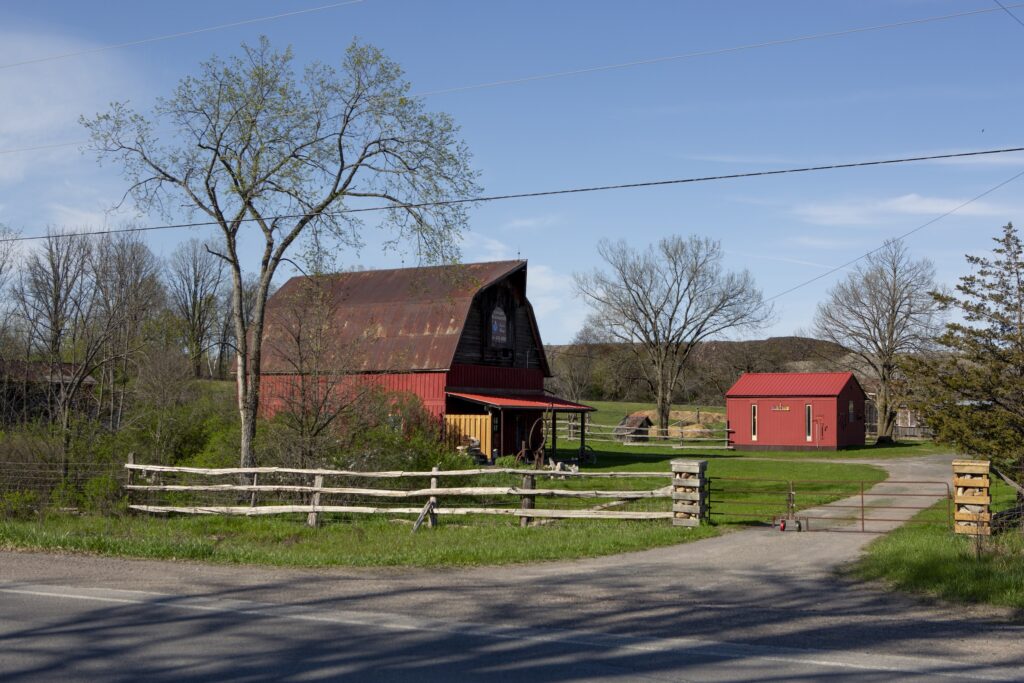
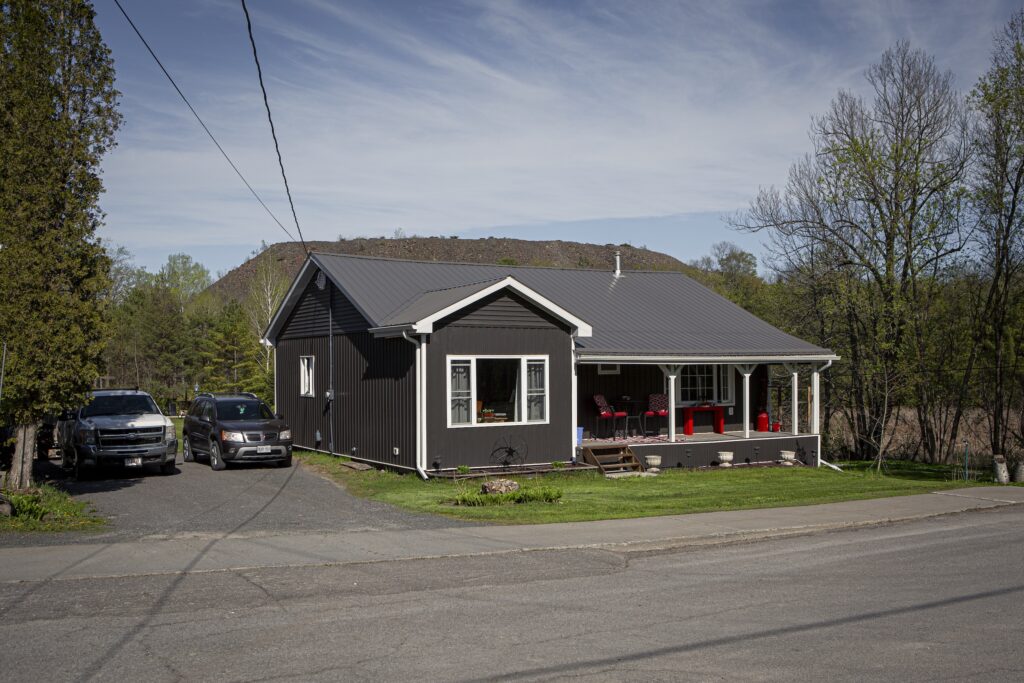
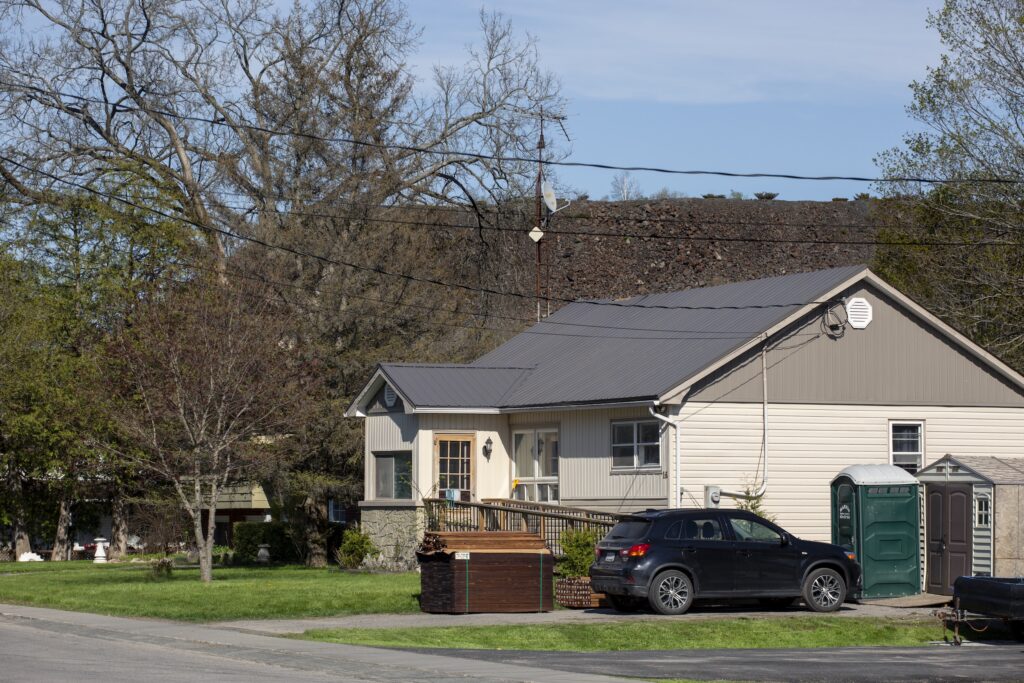
The cyan water in the reservoir is also free of contamination from mining operations, according to the local watershed authority, Quinte Conservation, which has publicly supported the project. That means any necessary releases into the local river system won’t risk contamination.
In terms of the pumped storage project’s environmental impact, reusing a brownfield site rather than cutting into a more natural area could play in its favour. Jeyakumar says there’s growing potential in making use of derelict sites for clean energy production.
“It’s something we should really be paying more attention to as we build out more in our grid,” she says. “You should be looking at how do we reduce the impact on the local habitat? And I think that’s where brownfield projects could be a potential opportunity.”
As Canada moves toward a coal phase-out by 2030, a number of mines will inevitably close. Turning abandoned mines into hydro storage projects is hardly commonplace, even globally, so she sees the Marmora project, as well as one being proposed in a former coal mine in Hinton, Alta., as a chance to learn.
“The other opportunity is also to get economic development opportunities that provide jobs and revenue for local communities,” Jeyakumar says. Reclaiming old mine sites presents a chance, she says, for just transition.
That’s an important consideration in Marmora. While Marmoraton closed more than four decades ago, its imprint remains.
When the mine was at its peak, O’Neill says, the town had three grocery stores, a car dealership, a Simpsons and a Sears, jewellery stores and several restaurants.
During most of the mine’s life, the town had three doctors and a dentist, she says. Today, the municipality is trying desperately to court just one doctor, even offering up living accommodations as part of the package.
The town has one grocery store now and a couple convenience stores and gas stations. On Forsyth Street downtown, a few pharmacies, pizza joints and other stores sit among vacant storefronts. The need for a boost in the local economy has become increasingly clear over the past two years of the COVID-19 pandemic.
The median household income in Marmora is around $50,000, according to the township. At the same time, the pandemic led city cottagers to become year-round residents, with higher salaries and expectations of better services than the town can provide.
O’Neill sees the pumped storage project as a step toward a stronger local economy, and then improved infrastructure and services.
“If people were able to get better jobs that paid more, there’d be more compliance and acceptance of a higher tax rate,” she says.
Most of those jobs won’t be at the storage facility: while construction will bring an influx of jobs and workers to the area, Wright says its general operation doesn’t require a significant number of staff. But the larger view for the site includes tourism and recreational use, with trails and lookout points on the man-made mountain that’s currently off limits to the public.
This would build on the region’s emergence as a spot for outdoor recreation. Just above a dam on the Crowe River, people scuba dive regularly. There are also hiking and walking trails, including one alongside the river. The mayor says a group is working to set up ATV tours and, of late, there’s been a lot of movement in commercial real estate.
The town commissioned a study on the economic impacts of the pumped storage project, finding it could add 381 tourism jobs in the county, with the potential to bring in $32 million per year in tourism-related revenue.
The future possibilities for the site, and all the different ways a former mine can take on new life, was part of what piqued Wright’s interest in the project in the first place. He’s a landscape architect by training.
“When you think about it, what more of a yield can you ask for?” he says. The iron that was once here went into buildings and bridges. The waste — still flecked with dark patches of iron that make an average-size rock improbably heavy — was laid for highways. And now the old mine could offer a much-needed energy solution. That’s a lot of use, Wright says.
The point where we’re standing has a 360-degree view of the area surrounding us, and would become a public lookout. A church spire rises up from the town and O’Neill points out an area behind it called Naylors Marsh, where clay was once harvested to make brick. “Generally speaking, I think the project, and the company, kind of respects the community culture here,” O’Neill says. “As we’re moving through the community’s process, I think it will only be a good thing for this area.”
Back in the post-war days, she says, the town had a hockey team, the Marmora Millionaires, that won the Ontario championship several years, and regular big-band shows. “Lots of those things that have kind of, they’re not existent anymore,” she says. “This town was strong in culture and community and I would really like to see that rejuvenated.”
Updated on July 19, 2022, at 10:30 a.m. ET: This story has been updated to correct the number of houses the 400-megawatt Marmora pumped storage project could power over a five-hour period. The system could power 400,000 houses, as much as about Mississauga and Brampton combined, according to Northland Power, not 1,000, which would just cover a small town.
Updated on July 20, 2022, at 1:12 p.m. ET: The map in this story has been updated to correct the spelling of Stirling-Marmora Road.
Get the inside scoop on The Narwhal’s environment and climate reporting by signing up for our free newsletter. On Sunday, across most of Canada, the...
Continue readingFrom heritage sites to John A. Macdonald’s statue, we need to reconsider how we selectively...
Pipeline workers failed to properly assess endangered bat habitat before clearing land in northwest British...
Danielle Smith also met with an undisclosed 'global oil and petrochemical multinational' to talk about...
